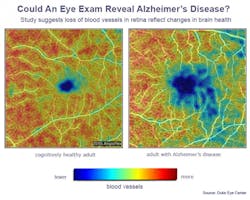OCT angiography eye test could diagnose Alzheimer's before symptoms appear
In a study of more than 200 people, researchers at the Duke Eye Center (Durham, NC) used a noninvasive optical coherence tomography (OCT) imaging method to demonstrate that the loss of blood vessels in the retina could signal Alzheimer's disease, and do so even before symptoms are present.
In people with healthy brains, microscopic blood vessels form a dense web at the back of the eye inside the retina, as seen in 133 participants in a control group. However, in the eyes of 39 people with Alzheimer's disease, that web was less dense and even sparse in places. The differences in density were statistically significant after researchers controlled for factors including age, sex, and level of education, says Duke ophthalmologist and retinal surgeon Sharon Fekrat, MD, the study's senior author.
"We're measuring blood vessels that can't be seen during a regular eye exam and we're doing that with relatively new noninvasive technology that takes high-resolution images of very small blood vessels within the retina in just a few minutes," Fekrat explains. "It's possible that these changes in blood vessel density in the retina could mirror what's going on in the tiny blood vessels in the brain, perhaps before we are able to detect any changes in cognition."
The study found differences in the retinas of those with Alzheimer's disease when compared to healthy people and to those with mild cognitive impairment, often a precursor to Alzheimer's disease.
"We know that there are changes that occur in the brain in the small blood vessels in people with Alzheimer's disease, and because the retina is an extension of the brain, we wanted to investigate whether these changes could be detected in the retina using a new technology that is less invasive and easy to obtain," says Dilraj S. Grewal, M.D., a Duke ophthalmologist and retinal surgeon and a lead author on the study. The Duke study used optical coherence tomography angiography (OCTA), which employs light waves that reveal blood flow in every layer of the retina.
Related: OCT angiography’s gains
An OCTA scan could even reveal changes in tiny capillaries before blood vessel changes show up on a brain scan such as an MRI or cerebral angiogram, which highlight only larger blood vessels. Such techniques to study the brain are invasive and costly.
"Ultimately, the goal would be to use this technology to detect Alzheimer's early, before symptoms of memory loss are evident, and be able to monitor these changes over time in participants of clinical trials studying new Alzheimer's treatments," Fekrat says.
Full details of the work appear in the journal Ophthalmology Retina.
